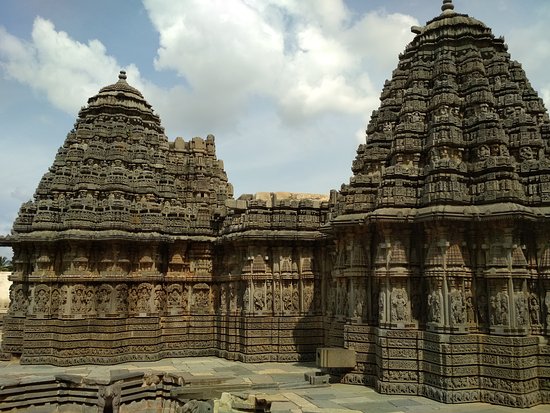ॐ श्री गुरुभ्यो नमः ॐ श्री शिवानन्दाय नमः ॐ श्री चिदानन्दाय नमःॐ श्री दुर्गायै नमः
Source of all Images in this Blog-post : Google Images : ‘Google Image Search’ will reveal the multiple sources of every single image shared here. For more details, kindly see ‘Disclaimer‘
Explore Chennakeshava Temple, Somanathapura on TripAdvisor
Read Tourist Reviews on Tripadvisor

The Chennakesava Temple, also referred to as Chennakeshava Temple and Keshava Temple, is a Vaishnava Hindu temple on the banks of River Kaveri at Somanathapura in Karnataka in India.
The temple was consecrated in 1258 CE by Somanatha Dandanayaka, a general of the Hoysala King Narasimha III. It is located 38 kilometres east of Mysuru city.
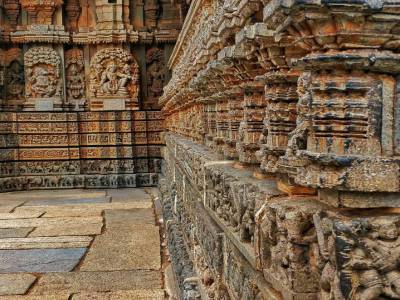
The ornate temple is a model illustration of the Hoysala architecture. The temple is enclosed in a courtyard with a pillared corridor of small shrines – all damaged now.
The main temple in the center is on a high star-shaped platform with three symmetrical sanctums (Garbha-Griha).
The western sanctum was for a statue of Kesava (missing now), the northern sanctum of Janardhana and the southern sanctum of Venugopala, all forms of Vishnu.

The sanctums share a common community hall (Sabha-Mandapa) with many pillars. The outer walls, the inner walls, the pillars and the ceiling of the temple are intricately carved with theological iconography of Hinduism and display extensive friezes of Hindu scriptures such as the Ramayana, the Mahabharata and the Bhagavata Purana.
The Chennakesava temple represents the climax of the development in Hoysala temple architecture and yet is also unique in many ways.
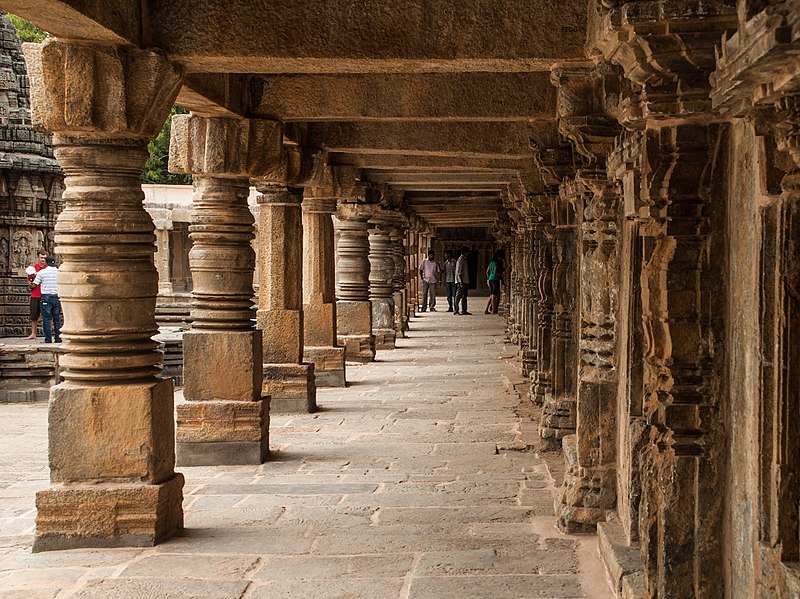
History
The Somanathapura town was founded in the 13th century by a general named Somanatha. He was working for the Hoysala King Narasimha III.
Somanatha created an Agrahara ( A colony for Brahmins), that granted land to Brahmins and dedicated resources to build and maintain temples therein.

The town (Pura) became known after the name of the patron, Somanatha-pura.
In the middle of the new settlement, Somanatha built the Kesava temple and consecrated it in 1258 CE. This was a Vaishnavism tradition temple.

In addition to this temple, Somanatha consecrated a Shaivism tradition related Panchalinga temple (Temple of five Lingas)) in the east-northeast corner of the land grant. He also built a fort wall around the land, but these are now in ruins.

According to the inscriptions and textual evidence, Somanatha additionally built the Purahara, Narasimhesvara, Murahara, Lakshminarasimha and Yoganarayana temples in Hoysala style in the region.

But all these temples except the Lakshminarasimha have disappeared, after wars between the Hindu kingdoms and Muslim Sultanates ravaged the region.
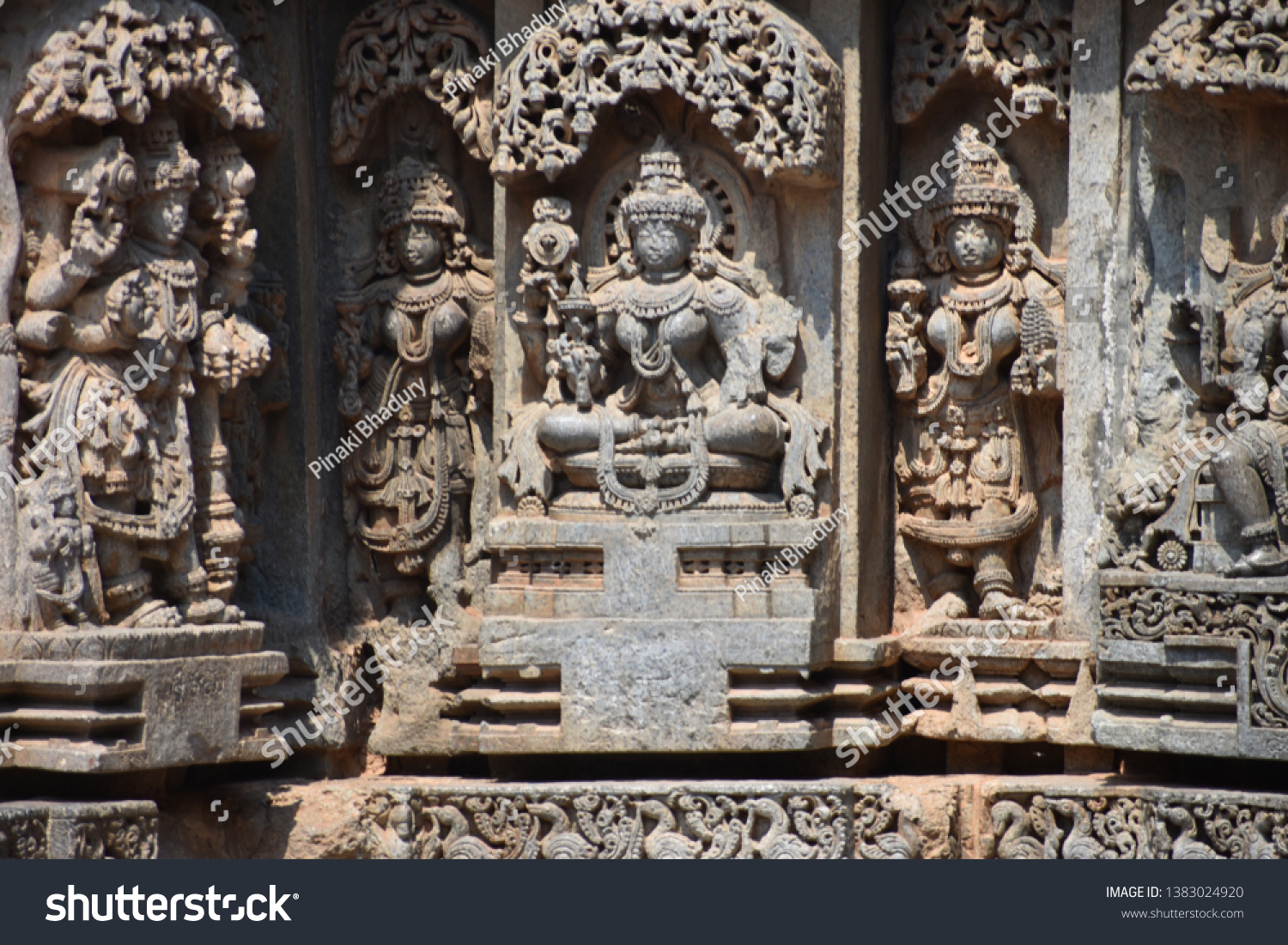
The Lakshminarasimha temple is also in ruins. From the other disappeared temples, the sanctum image of Yoganarayana temple is only known surviving artwork, but this temple too is in a damaged form.

The Kesava temple too was badly damaged, according to 15th-century inscriptions. It was repaired in the 16th century with financial support and grants by the emperors of the Vijayanagara Empire.

The repairs are evidenced by the different color of stones and quality of work in the veranda and parts of the northern tower and platform of the main temple.
The repaired temple was damaged in the 19th century, then repaired again in the early 20th century by the colonial era Mysore government.

The Kesava temple is one of some 1,500 Hindu and Jain temples built by the Hoysala Empire kings in different parts of their kingdom. The other well studied Hoysala temples include those at Belur and Halebidu.

The temple was destroyed during Muslim attacks in the Hoysala kingdoms. The first attack was by Malik Kafur, Alauddin Khilji’s general in 1311 and in 1326 Muhammad Bin Tughlaq destroyed the remaining structures.
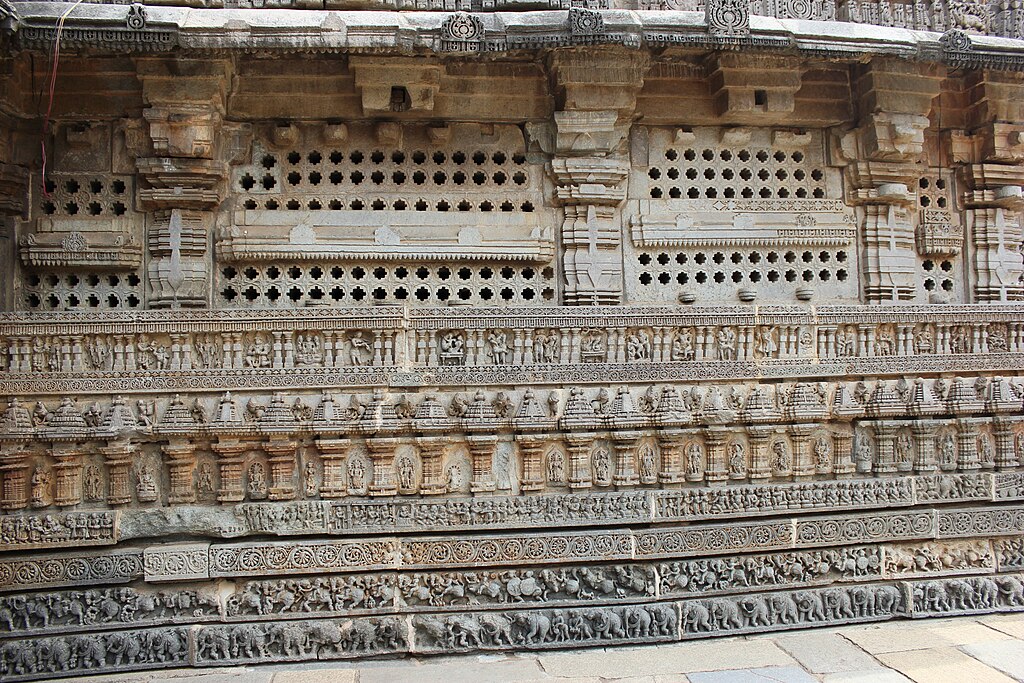
Some parts of the temples were restored by Vijayanagara Kings and later by Wodeyars of Mysuru.
Description of the temple
Keshava, Janardhana and Venugopala are names found in the Bhagavad Gita, all in the context of Krishna. The term Chennakeśava means ‘Handsome Keshava’.

The Keshava temple at the Somanathapura is a temple of the Vaishnavism tradition within Hinduism, and one of the many Keshava temples built in or before the 13th century in different parts of India, as well as in Belur in 1117 CE about 170 kilometres away.

Stambha before the gate of the temple (left); the view of the temple from the mantapa with inscription rocks.
The Keshava temple at Somanathapura faces east and is enclosed in a walled courtyard with a major gate (Mahadvara). Outside the walls before the gate stands a tall pillar, which once had a Garuda statue on top, now missing.
Inside the gate, to the left are vertical standing inscription stones. These stones have the form of the hero stones, with the top decorated with Hindu iconography as well as miniature reliefs of Keshava, Janardhana and Venugopala.

The inscription is in old Kannada. The small entrance mandapa is supported by lathe-carved soapstone pillars.
The temple is carved from soapstone, that is soft in quarry but hardens when exposed to air. This is not locally available and must have been imported from another part of South India. It enabled the artists to shape and carve out intricate details for the artwork.
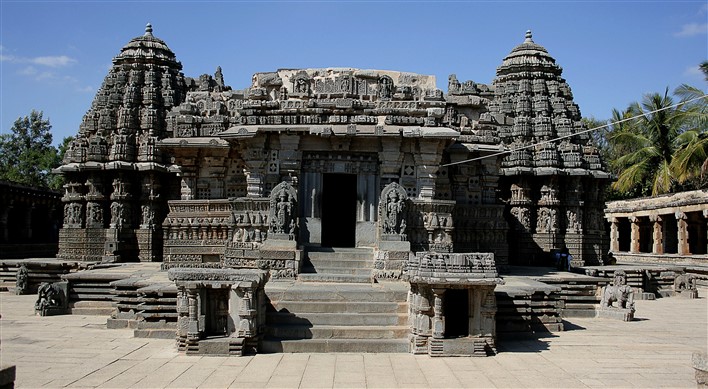
The temple has a large open public courtyard surrounded by the walled enclosure, with the main three-towered temple in the center. The courtyard wall frames a rectangular veranda and an array of small shrines.

Architecture of the temple
The northern and southern row of small shrines inside the pillared courtyard corridor consists of eighteen single shrine and one linked-double shrine each. The linked-double shrine is at the northwestern and southwestern corners of the courtyard.
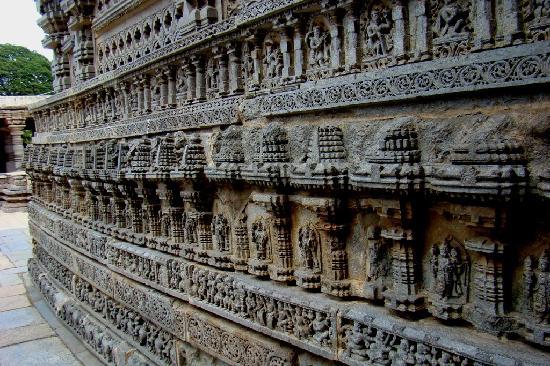
The western row consists of fourteen small shrines, while the eastern row consists of eight single small shrines and two linked-double shrines.
In total, the Kesava temple consists of 58 small shrines, 4 small double shrines, 2 near entrance, and the main central temple.
.jpg)
The 64 corridor shrines once featured Vedic and Puranic deities and rooms for pilgrims. The statues in the smaller shrines were defaced, their limbs broken or destroyed.
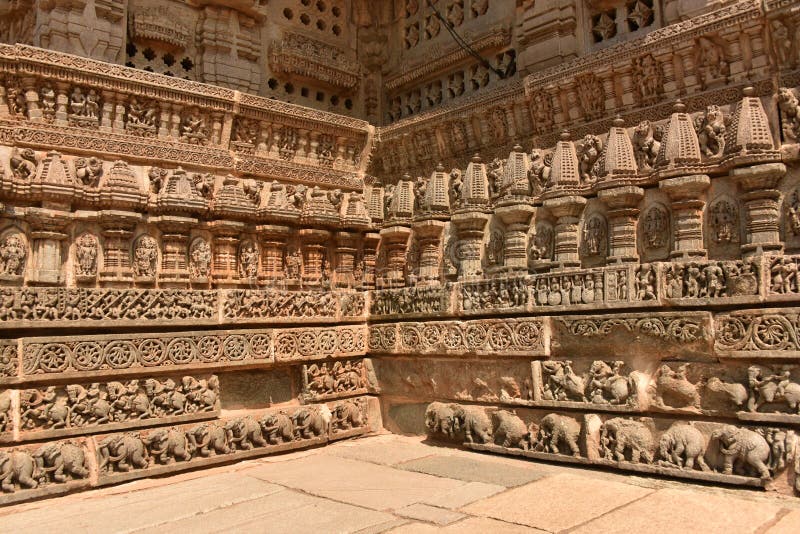
Some of the recovered broken pieces are in a heap inside the temple. The collection includes Jaina statues as well as numerous Hindu statues.
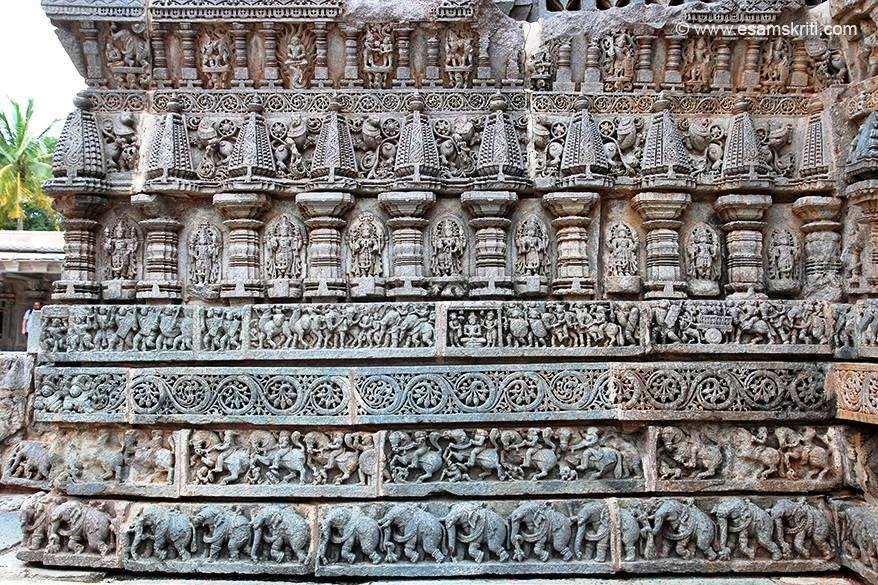
The ceiling of the southern array of shrines has carvings on its ceiling. The northern array also mostly lacks any ceiling art work except near the stairs in the middle, while the eastern array shows the greatest signs of damage and restoration with most small shrines missing but for signs of their foundation.

The main temple is built on a Jagati, which symbolizes worldly platform. It is about 3 feet high, star-shaped and has stone steps at its east end for the visitor to climb up to it.
.jpg)
Near the stairs, on each side are two Dvarapala (guardian) shrines but these are damaged. The platform around the temple serves as the circumambulation passage.
The raised Jagati platform circles around the main temple with a broad walking space. It is the Pradakshina Patha (circumambulation path), and is supposed to be walked in a clockwise manner in order to pictorially read the Ramayana, Mahabharata and Bhagavata Purana legends in the correct sequence.
The eastern side of the platform is rectangular, while the space below the Vimana (temple tower) mirrors the pointed star tower shape, with nine points on each side and two linking edges (a total of 29).
A stone elephant originally stood at each star point end of the platform, but only 11 of the 15 original have survived in a damaged condition.
On the sides of the star side and where two stars of the Jagati platform meet were 14 mid size images likely of Nagas and 58 images of Yakshas but all of this are now missing.
The temple premises stores 7 of the broken pieces found in the early 20th century.
The platform appears from a distance to be five stacks from the careful moulding. From the Jagati level, there are four stone steps that leads the devotee into the temple’s Sabha Mandapa inside.
The hall appears to be rectangular, yet consists of two fused squares and a rectangle. A small square is at the entrance, the largest square in the middle, and a rectangle facing the three sanctum (Garbha Griha), all supported by intricately carved pillars.
The main hall opens to each sanctum through a small square shaped Puja Mandapa. The three sanctums house Keshava (image lost), Janardhana and Venugopala.
Above each of these sanctums rise the 16 pointed star shaped North Indian style tower (Shikara).
Outer walls – Lower levels
The outer wall of the main temple consists of parallel horizontal bands of artwork carved above the circumambulatory platform. It has three major section, the basement band, the wall band and the top band.
The lowest band in the basement section shows a row of elephants mostly marching to the left in the clockwise direction the devotee is expected to walk.
The elephants are not exact copy of each other, rather show different natural expressions and playfulness of elephants. Some show elephants in war, throwing enemies; while others show them teasing the riders in front.
The band above the elephants is of horses with armed riders, depicting a military march. In some spots, camels substitute for horses suggesting that the Hoysala had adopted camels into their army.
Some spots also show battle scene with horses. In various places, the artists added humor by placing dwarfs and monkeys supporting the front raised leg of the horses.
The band above the horsemen friezes is a scroll of nature. It shows flowers, fruits, occasionally some peacocks and wildlife.
The band above it is the mythology frieze. It depicts the legends and spiritual stories found in the Ramayana, the Puranas particularly the Bhagavata Purana and lastly the Mahabharata.
There are numerous panels around the temple that tell the various Hindu fables and stories.
Ramayana
Only the early Parvas of the Ramayana are depicted. A few shown at the Kesava temple include :
- Dasharatha makes ritual offerings and prayers for children. Rama and his brothers are born.
- Babies rocked in cradles, another frieze shows Rama and his brothers crawling on all fours.
- School life, martial lessons.
- Young Rama slays Tataka to protect the Rishis.
- Vishvamitra, Rama and Lakshmana at Janaka’s court. Another shows Sita marrying him.
- Married Rama and his brothers in Ayodhya.
- Rama, Lakshmana and Sita leave for their exile. They wander in forests and meet various sages.
- Viradha attacks Sita, Rama slays him.
- Surpanakhi episode.
- Golden deer legend.
- Ravana abducts Sita. Another frieze shows him slaying Jatayu.
- Hanuman and Sugriva meet and join Rama.
The rest of the Ramayana is not depicted, and the Bhagavata Purana starts thereafter.
Bhagavatha Purana
The band around the western shrine depicts the Bhagavata Purana. Some scenes of the Bhagavata are repeated. A few of the legends from it shown at the Kesava temple include :
- Reclining Vishnu in the cosmic ocean story.
- Vasudeva’s marriage legend.
- Baby Krishna being carried across the river by Vasudeva.
- Various friezes of baby Krishna feeding in Gokula, rocked in cradle, crawling on all fours.
- Krishna kills Putana and Sakatasura.
- Toddler Krishna steals butter.
- Krishan lifts Govardhana.
- Various friezes of Krishna playing with enchanted gopis.
- Krishna kills various demons and ultimately slays Kamsa.
Mahabharata
A few of the scenes shown on the outer wall of the temple include :
- Dhritarashtra’s court.
- The rivalry between Pandava and Kauravas as they are growing up.
- Pandavas leaving for forest.
- Bhima marries Hidimbi, birth of Ghatotkacha.
- Pandavas meet Drupada and stay at a potter’s house.
- Draupadi’s marriage partner selection ceremony.
- Arjuna hits the fish target, Draupadi picks him as her husband.
- Pandavas return with Draupadi.
- Yudhisthira plays dice, loses.
- War scenes. Krishna advises the Pandavas.
- A scene where a hero does Yoga seated in an Asana, while admirers garland him.
- Pandavas win. Their return to kingdom.
Outer walls – Upper levels
Mantapa walls
Above the lower level band with friezes depicting the Hindu fables and legends is a band of mythical Makaras (a creature based on the fusion of various animals) and then a band of decorative peacocks.
Above the peacock band of nearly 200 relief carvings are rows of secular life of the people and small size deity reliefs that wraps around only the Sabha Mantapa (community hall) part of the main temple. Most of these are defaced and damaged. Some are difficult to identify.
The deity-related reliefs are predominantly Vishnu shown in his various aspects and avatars in the Vaishnavism tradition, but they include Shiva of the Shaivism tradition, Devis of the Shaktism tradition and Surya of the Saura tradition of Hinduism.
Saraswati with the Vedas and her Alapini VeenaThe Kesava temple has hundreds of reliefs, mostly Vaishnava. They include Shaiva, Shakti and Saura themes.
The reliefs showing common life of the people include festive scenes, dancers in various Mudras, musicians with 13th century musical instruments, couples in courtship and sexual scenes, mothers nurturing babies, hunters and other professionals with pets such as dogs, soldiers, Yogi, Rishi, individuals in Namaste posture, couples praying and others.
These reliefs also include numerous friezes showing the story of Prahlada, Hiranyakashipu and Vishnu Avatara Narasimha.
Garbha Griha Tower Walls
In the case of the three towers, above the peacock band of carvings is a row of larger size deity reliefs that wraps around the temple.
There are about 90 reliefs showing mostly Vishnu with Lakshmi, as well as Shakti, Shiva, Brahma, Saraswati, Indra, Indrani, Kama, Rati, and others.
Most of these are also partially defaced such as broken noses, chopped limbs, chopped out stone jewelry and show other forms of damage. Some are therefore difficult to identify.
Some illustrative carvings of large images include :
- Tandava Ganesha
- Dancing Saraswati
- Keshava, Venugopala, Janardana, Krishna legends
- Vishnu to be same as Indra, Varuna, Yama, Vasudeva, Yoganarayana, Matsya, Kurma, Varaha, Narasimha, Vamana, Parashurama, Rama, Krishna and Buddha
- Dancing Lakshmi in various forms
- Brahma with and without beard
- Harihara (half Shiva, half Vishnu) in various forms
- Surya
- Durga as Mahishasuramardini
- Dancing Vishnu
The first sixty and the last sixty reliefs have a superior finish and details, while the middle sixty five (#61 to #134) panels are less detailed. Some of the panels are signed below by the artist.
Read more on the Wikipedia page of Chennakeshava Temple, Somanathapura
